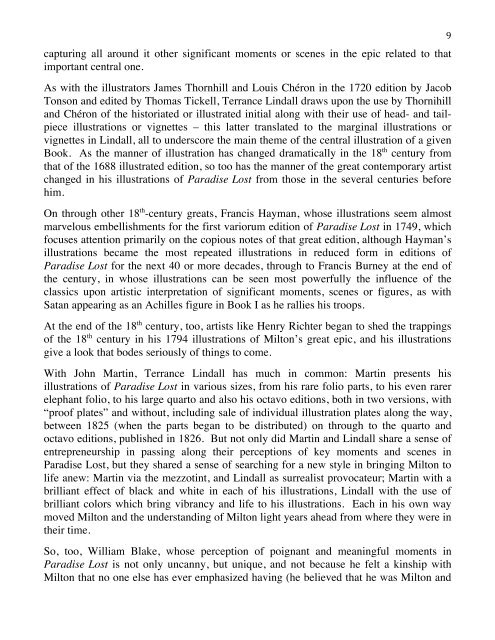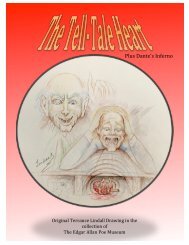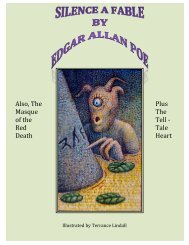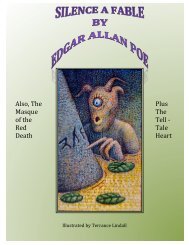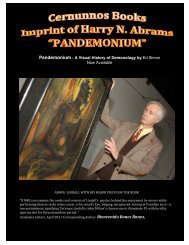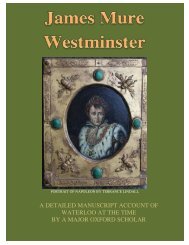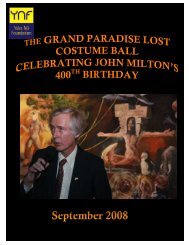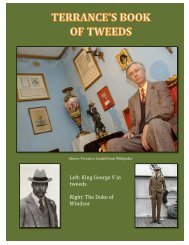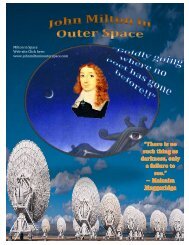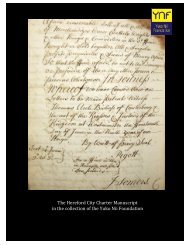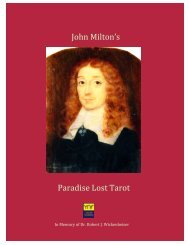The Acrostic Paradise Lost by John Milton and Terrance Lindall
The first ever acrostic that tells the story as the proem goes along. Contains most of Lindall's art for Paradise Lost. Signed and numbered hardcover is $300. milton@wahcenter.net
The first ever acrostic that tells the story as the proem goes along. Contains most of Lindall's art for Paradise Lost. Signed and numbered hardcover is $300. milton@wahcenter.net
You also want an ePaper? Increase the reach of your titles
YUMPU automatically turns print PDFs into web optimized ePapers that Google loves.
! 9!<br />
capturing all around it other significant moments or scenes in the epic related to that<br />
important central one.<br />
As with the illustrators James Thornhill <strong>and</strong> Louis Chéron in the 1720 edition <strong>by</strong> Jacob<br />
Tonson <strong>and</strong> edited <strong>by</strong> Thomas Tickell, <strong>Terrance</strong> <strong>Lindall</strong> draws upon the use <strong>by</strong> Thornihill<br />
<strong>and</strong> Chéron of the historiated or illustrated initial along with their use of head- <strong>and</strong> tailpiece<br />
illustrations or vignettes – this latter translated to the marginal illustrations or<br />
vignettes in <strong>Lindall</strong>, all to underscore the main theme of the central illustration of a given<br />
Book. As the manner of illustration has changed dramatically in the 18 th century from<br />
that of the 1688 illustrated edition, so too has the manner of the great contemporary artist<br />
changed in his illustrations of <strong>Paradise</strong> <strong>Lost</strong> from those in the several centuries before<br />
him.<br />
On through other 18 th -century greats, Francis Hayman, whose illustrations seem almost<br />
marvelous embellishments for the first variorum edition of <strong>Paradise</strong> <strong>Lost</strong> in 1749, which<br />
focuses attention primarily on the copious notes of that great edition, although Hayman’s<br />
illustrations became the most repeated illustrations in reduced form in editions of<br />
<strong>Paradise</strong> <strong>Lost</strong> for the next 40 or more decades, through to Francis Burney at the end of<br />
the century, in whose illustrations can be seen most powerfully the influence of the<br />
classics upon artistic interpretation of significant moments, scenes or figures, as with<br />
Satan appearing as an Achilles figure in Book I as he rallies his troops.<br />
At the end of the 18 th century, too, artists like Henry Richter began to shed the trappings<br />
of the 18 th century in his 1794 illustrations of <strong>Milton</strong>’s great epic, <strong>and</strong> his illustrations<br />
give a look that bodes seriously of things to come.<br />
With <strong>John</strong> Martin, <strong>Terrance</strong> <strong>Lindall</strong> has much in common: Martin presents his<br />
illustrations of <strong>Paradise</strong> <strong>Lost</strong> in various sizes, from his rare folio parts, to his even rarer<br />
elephant folio, to his large quarto <strong>and</strong> also his octavo editions, both in two versions, with<br />
“proof plates” <strong>and</strong> without, including sale of individual illustration plates along the way,<br />
between 1825 (when the parts began to be distributed) on through to the quarto <strong>and</strong><br />
octavo editions, published in 1826. But not only did Martin <strong>and</strong> <strong>Lindall</strong> share a sense of<br />
entrepreneurship in passing along their perceptions of key moments <strong>and</strong> scenes in<br />
<strong>Paradise</strong> <strong>Lost</strong>, but they shared a sense of searching for a new style in bringing <strong>Milton</strong> to<br />
life anew: Martin via the mezzotint, <strong>and</strong> <strong>Lindall</strong> as surrealist provocateur; Martin with a<br />
brilliant effect of black <strong>and</strong> white in each of his illustrations, <strong>Lindall</strong> with the use of<br />
brilliant colors which bring vibrancy <strong>and</strong> life to his illustrations. Each in his own way<br />
moved <strong>Milton</strong> <strong>and</strong> the underst<strong>and</strong>ing of <strong>Milton</strong> light years ahead from where they were in<br />
their time.<br />
So, too, William Blake, whose perception of poignant <strong>and</strong> meaningful moments in<br />
<strong>Paradise</strong> <strong>Lost</strong> is not only uncanny, but unique, <strong>and</strong> not because he felt a kinship with<br />
<strong>Milton</strong> that no one else has ever emphasized having (he believed that he was <strong>Milton</strong> <strong>and</strong>


